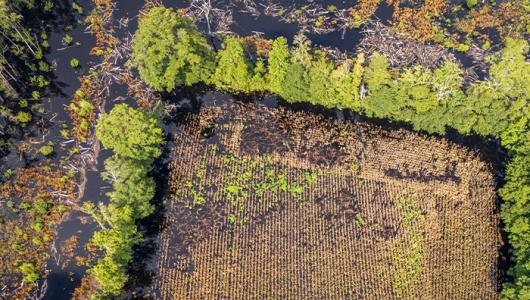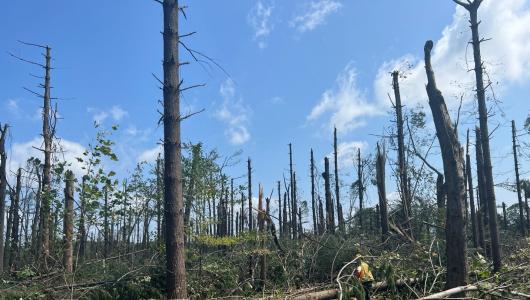Much of Missouri is now suffering from drought. But one farmer said a change in his management system has made his land more resilient to it.
Adam Boman, owner of Good Life Grass Farms, raises grass-fed beef under a rotational grazing system that is providing plenty of forage for his herd despite the drought.
Adam Bowman and his family raise grass-fed beef cattle and lambs in Lawrence County, Missouri.
“Even through this summer, I shouldn’t have to feed any hay,” Boman said. “There is still plenty of fescue in the fields. It is still green but has stopped growing for sure. But thus far, we are getting enough rain here and there to where the warm-season grasses are continuing to grow.”
Boman, who also raises grass-fed lambs on his Lawrence County farm, said the grazing system allows him to rotate 22 cattle through 13 permanent paddocks that can be turned into 26 with temporary fencing. The system allows him to manage the grass resource so that it does not get overgrazed, and it builds in plenty of rest periods for the grass to recover.
Building Resilience on the Farm
After the Bomans purchased the farm in 2013, they applied for assistance from the USDA’s Natural Resources Conservation Service to convert land along Clear Creek from cropland to pasture. Rita Mueller, a resource conservationist with the Natural Resources Conservation Service, said financial and technical assistance helped the Bomans install a well, pump plant, pipeline, water tanks, fencing and windbreak, in addition to establishing non-toxic, novel endophyte tall fescue.
Boman left his job as a fisheries biologist in 2015 to devote more time to farming and to installing the practices recommended by USDA. He said that USDA’ assistance greatly sped up his goal of leaving his job and fulfilling his dream of being a full-time grass farmer.
“We love projects like this because they improve the health of the soil and protect the quality of the water in the creek,” Mueller said. “And on top of that it feels nice being able to help people like Adam and Teresa enjoy the lifestyles they desire.”
Boman said the grazing system has allowed him to make three important management changes: evenly grazing half of the growth and leaving the other half, increasing days of rest between grazing, and keeping his animals only eating the high-energy grass tips during fast-growing periods in early fall and early spring.
With financial assistance through NRCS’ Environmental Quality Incentives Program, Boman implemented a rotational grazing system.
He said these practices create more drought resilience, in part because accumulated grass cover from spring keeps soil temperatures lower and helps retain soil moisture in the summer. He is also growing more forage per acre while maintaining stocking rates and feeding much less hay.
“My stocking rate is 1.9 acres per animal unit. That is close to the typical stocking rate in my area. But the impressive part is how long we can graze without feeding hay,” Boman said. “By leaving grass behind you throughout the year, once winter hits you end up with a large amount of stockpiled grass that can be strip-grazed once grass stops growing. Last year we grazed through the dry spell in the fall all the way to January 5. Cutting down on hay usage makes the farm much more profitable.”
Boman’s grazing system produces enough forage for a longer grazing season, only having to feed hay for two months instead of six.
Boman said he can’t imagine operating without his rotational-grazing system.
“People say ‘but you have to move them every day,’ but it only takes five minutes,” he said.
USDA Assistance for Drought
While conservation practices help producers like Boman reduce the impacts of drought, USDA offers a variety of programs to help farmers recover from drought and other natural disasters.
In August, USDA designated 47 counties in Missouri as primary natural disaster areas, making them eligible for Farm Service Agency emergency loans and other programs. If you’re a producer impacted by drought or other natural disasters, use the Disaster Assistance Discovery Tool to find out which programs are available to help you recover.
Charlie Rahm is a public affairs specialist with USDA’s Natural Resources Conservation Service in Missouri. He can be reached at charlie.rahm@mo.usda.gov.


